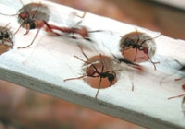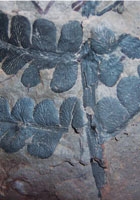Highway maintenance in the rain forest
In some modern rain forests of Central and South America certain army ants (Eciton burchellii) conduct predatory raids, containing up to 200,000 foraging ants. But the trails they follow can be extremely uneven and full of ‘potholes’ as they pass over leaves and branches on the forest floor. Remarkably, some of the ants use their bodies to plug potholes in the trail leading back to the nest, making a flatter surface so that prey can be delivered to the developing young at maximum speed.
Dr Scott Powell and Professor Nigel Franks, from the School of Biological Sciences, observed this behaviour by getting the ants to ‘walk the plank’. They drilled different sized holes into planks of wood and then inserted the planks into the army ants’ trails. They found that individuals size-match to the hole they plug, and that several ants would co-operate to plug larger holes. When the traffic has passed, the down-trodden ants climb out of the potholes and follow their nest-mates home.
This research demonstrates that a simple but highly specialised behaviour performed by a minority of ant workers can improve the performance of the majority, resulting in a clear benefit for the society as a whole. In other words, the behaviour of the pothole pluggers more than compensates for them not carrying prey themselves. It also suggests that these benefits are a consequence of the unusual and derived foraging strategy of the army ant, which high-lights the importance of considering ecology and evolutionary history in the study of social organisation in animal societies.
This research was funded by the Biotechnology and Biological Sciences Research Council.
The world’s first rain forest
What must have been one of the first-ever rain forests to grow on this planet has been discovered in the USA by Dr Howard Falcon-Lang from the Department of Earth Sciences, and US colleagues. The spectacular 300-million-year-old forest is composed of a bizarre mixture of extinct plants. Abundant club mosses, more than 40 metres high, tower over a sub-canopy of tree ferns, intermixed with shrubs and tree-sized horsetails.
It is the largest fossilised forest ever found, covering an area 10 by 10 kilometres (which would cover the city of Bristol). The forest was preserved following a major earthquake which caused the whole region to drop below sea level, whereupon it rapidly became buried in mud, preserving it forever. The fossils provide a unique snapshot of what tropical rainforests were like 300 million year ago, at a time when gigantic woodlice, several feet across, crawled on the forest floor and equally large dragonflies flew through its branches.
The study reconstructs a Carboniferous rain forest at the largest spatial scale ever attempted. The fossils show that the Earth’s first rain forests were highly diverse and that the kinds of tree species changed across the ancient landscape. Prior to this work very little was known about the ecological preferences and community structure of these ancient plants. This magnificent discovery allows the team to track how the species make-up of the forest changed across the landscape, and how that species make-up is affected by subtle differences in the local environment.
This research was funded by the Natural Environment Research Council.

